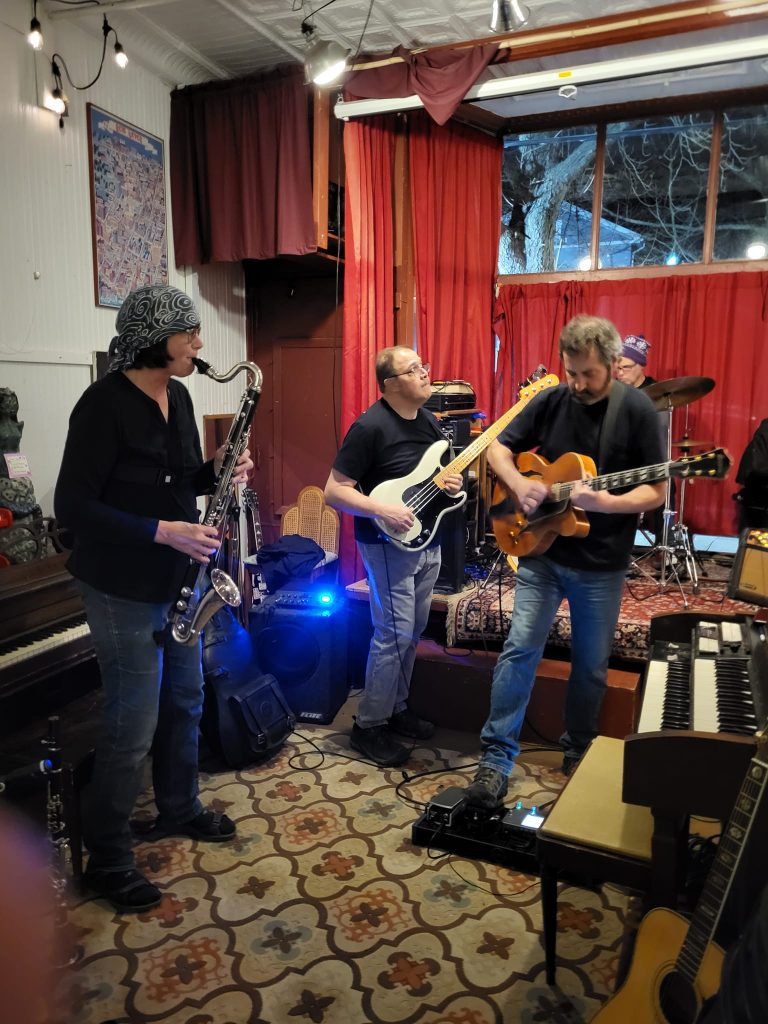
Workshop & organizational meetings will be held on the last Monday of each month in the performance space at the Ely Center of Contemporary Art , 51 Trumbull Street, New Haven, CT 06511
It will run from 7:30pm until about 9pm.
Bring your instrument, your ideas & your imagination.
NHIC workshops are a chance for musicians to get together and create music while developing improvisational skills. It is also a chance to develop a group vocabulary to be used for group performances. A series of exercises are used to develop improvisational techniques and strategies. There is a moderator who picks the exercises and keeps track of time. There are always free improvs.
Guidelines
Be present, LISTEN, leave space, Don’t worry. Play it like you mean it. The only mistake is to be timid.
Sustain
Play one continuous tone in any way you see fit. Listen to everyone. When directed, play a different tone.
A good way to balance the room.
Notes
Everyone takes a note value (1/4, 1/8, whole) and plays it repeatedly.
Change pitch, use rests.
Circulation
Everyone plays a note or sound in turn.
- Can have no pulse, or have a pulse where everyone gets a beat.
- Develop the ideas that come. Remember your beat, but play elsewhere as needed.
- Then go back to one at a time with a beat and end where we started.
Free
Just Play
- Can use a directive like fast, slow, groovey, punk, etc.
- Can also just be a title.
- Can also have a leader to start and end.
Duos/Trios
Two people play, one drops out and another picks up.
- Go around the room this way.
- Trios can work this way too.
- Can assign roles or not.
Roles
People are assigned roles for each section of an improv.
REPEAT, SUPPORT, COLOR, LEAD, FREE.
- Or Rhythm, Color, Lead.
- Works very well as trios around the room: Color, Rhythm, Lead.
- When lead player stops, rhythm becomes lead, color becomes rhythm and next in line becomes color.
Conductor
Someone non-verbally directs the improvisation, does not play.
A conductor can be helpful with any exercise or performance.
Groovester
Somebody starts an ostinato, others add their own sequentially.
- Hold onto yours, but develop it.
- Then play it exactly again and develop it more. Go somewhere else.
- Last player to start ends it by completely stopping.
- Everyone else stops in reverse order until the one who started is playing his/her original idea alone.
Spaces
Player1 starts.
- Player 2 plays in the spaces of Player 1.
- Player3 plays in the spaces of player 2.
- Etc. ..
- Finally player 1 plays in the spaces of the last player.
- Leave Spaces.
Styles
Someone plays a style of music they are familiar with (funk, polka, folk, thrash).
Everyone follows in any way they can.
When it wanes, someone throws in a different style.
Crescendo / Diminuendo
Increase density/dynamics smoothly over a set period
(15 seconds, 30 seconds, 2 minutes)
Decrease density/dynamics smoothly over a set period
(15 seconds, 30 seconds, 2 minutes)
Telephone
Someone plays a phrase.
The second player repeats what he can.
The third player repeats what she heard the second player play and so on.
Endings
Try to end gracefully. Give a time limit and a leader and a directive (slow, sudden).
Rally
Copy: Play a short phrase. Everyone else tries to play the same phrase. Next person plays a different phrase and so on around the room
Response: Play a short phrase. Everyone respond to that phrase (same length). Next person plays a different phrase and so on around the room
Combination: Alternate Copy and Response
Melodies & Notes
Split the room in two.
Half the Room play melodically thinking of phrasing.
The other half doesn’t